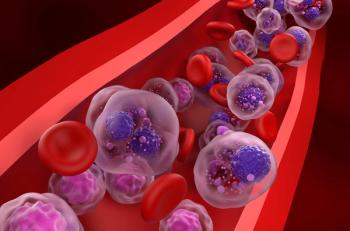
Risk Prediction Model Could Identify Patients With a Higher Risk of Pancreatic Cancer
Key Takeaways
- Pancreatic cancer's high mortality rate necessitates early detection to improve surgical viability and patient survival rates.
- Existing screening methods have high false positive rates, highlighting the need for improved risk identification processes.
A recent study presented a risk prediction model that effectively combined genetic and clinical factors with circulating biomarkers to identify people with a higher than normal risk of pancreatic cancer.
A recent study published in Cancer Epidemiology, Biomarkers & Prevention presented a risk prediction model that effectively combined genetic and clinical factors with circulating biomarkers to identify people with a significantly higher than normal risk of pancreatic cancer.1
Pancreatic cancer has a high mortality rate, with approximately 80% of those patients who are diagnosed with an advanced, incurable form of the disease, explained the study’s co-author Peter Kraft, PhD, professor of epidemiology at the Harvard T.H. Chan School of Public Health in Boston, in a press release. For this reason, catching the cancer at an earlier stage makes surgery more viable, which increases the chances of survival for patients.2
The existing screening techniques, such as magnetic resonance imaging (MRI), for pancreatic cancer in the general population has a high rate of false positives. However, an effective screening method remains vital in order to identify those at higher risk of pancreatic cancer, making the improvement of the identification process necessary.1
Known risk factors for pancreatic cancer include family history, chronic conditions such as diabetes and pancreatitis, and smoking. Kraft noted that prospective studies have shown that certain biomarkers tied to insulin resistance have also been shown to potentially influence risk.2
“These factors have been investigated individually, and in this study, we wanted to examine the combined effect of clinical factors, common genetic predisposition variants, and circulating biomarkers,” Kraft said in a press release.2
The study examined data from the Health Professionals’ Follow-up Study, the Nurses' Health Study, the Physicians' Health Study, and the Women's Health Initiative. The researchers analyzed data from 500 patients diagnosed with primary pancreatic adenocarcinoma between the years of 1984 and 2010, and included 1091 matched controls.1
Within the study, researchers restricted enrollment to include only US non-Hispanic Caucasian participants because the genomic risk variants have been confirmed in the US Caucasian population but not in other groups, Kraft explained.2
The data included information on lifestyle and clinical characteristics from patient questionnaires, blood samples, and genomic DNA from peripheral blood leukocytes of the participants. The researchers also used a weighted genetic risk score based on data from 2 genome-wide association studies.1
In order to appropriately assess risk, the researchers created 3 relative risk models that were used for men and women separately. One risk model featured only clinical factors, another added the weighted genetic risk score to the clinical factors, and the third added biomarkers that included proinsulin, adiponectin, IL-6, and total branched-chain amino acids.1
According to Kraft, the results of the study showed that each new level of data improved the “model fit,” which allowed for a more accurate identification of pancreatic cancer risk.2
In order to allow for this, the models identified subsets of participants with a 3 times or higher increased risk of pancreatic cancer than the general population.1
The model that featured only clinical characteristics identified 0.2% of men and 1.5% of women with a 3 times or higher increased risk, while the model that combined clinical and genetic factors identified 0.3% of men and 2.3% of women with a 3 times or higher increased risk.1
For the model that added weighted genetic risk score and circulating biomarkers, it identified 1.8% of men and 0.7% of women at 3 times or higher increased risk. The final integrated model identified 2% of men and 2.3% of women with at least 3 times higher than average risk over a 10 years follow-up period. The individuals in the top 1% of risk carried a 4% lifetime risk of pancreatic cancer.1
Although the current risk model is limited to the Caucasian population and still needs to be confirmed and studied in other populations, Kraft explained that the study does indicate that combining biomarkers with clinical and genetic factors can result in better identification of those who could benefit from screening and early detection of pancreatic cancer.2
“Like most cancers, pancreatic cancer is multifactorial,” Kraft said in a press release. “The more we are able to combine information from multiple domains, the better we will become at identifying those who could benefit from screening.”2
REFERENCES
- Kim J, Yuan C, Babic A, et al. Genetic and Circulating Biomarker Data Improve Risk Prediction for Pancreatic Cancer in the General Population. Cancer Epidemiology, Biomarkers & Prevention. 2020. doi: 10.1158/1055-9965.EPI-19-1389.
- New risk prediction model could identify those at higher risk of pancreatic cancer [news release]. Eurekalert. April 22, 2020. eurekalert.org/pub_releases/2020-04/aafc-nrp042020.php. Accessed April 23, 2020.
Newsletter
Stay informed on drug updates, treatment guidelines, and pharmacy practice trends—subscribe to Pharmacy Times for weekly clinical insights.






































































































































































































